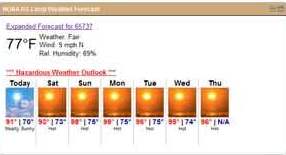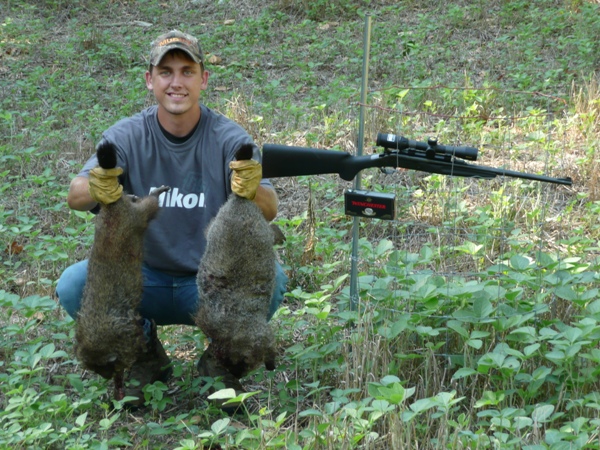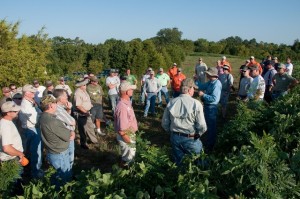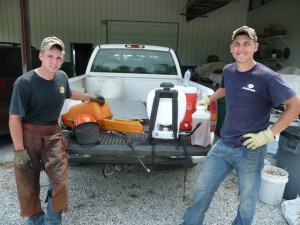Category: Deer Management
How to Analyze Drought Stress on Whitetails
Iowa State probably does more research about growing corn than any other university. I have learned much about growing corn from their publications and staff. Iowa State’s Extension department publishes a great E newsletter titled Crop Management News.
The issue today does a great job of explaining how temperature and soil moisture availability impact the productivity of corn. As I’ve referenced frequently on recent episodes of GrowingDeer.tv, when growing conditions cause stress on forage or grain crops the critters are stressed also.
It is easier to monitor the impact of stress caused by drought on a corn crop. Researchers can simply sample many aspects of the crop on a daily basis. In fact, some of these factors (amount the leaves are twisted, tassel development, etc.) can be estimated from the comfort of a pickup.
It’s much more difficult to monitor deer. They are mobile and tend to be nocturnal. They don’t like to be held or measured. Capturing deer is not necessary to know that they are stressed when crops are not expressing their full potential. I’m not aware of an exact index that compares bushels of corn produced per acre that equates to inches of antler development per age class of bucks.
However when corn, soybean, alfalfa, etc., production is limited by harsh growing conditions, it is certain that deer won’t express their full potential. For example, today there was an Associated Press article posted on Fox News that quoted the Texas AgriLife Extension Service as reporting that pregnant does are having difficulty carrying fawns to term and other fawns are being born prematurely due to heat stress. Likewise the agricultural crops are very unproductive or a total failure in many parts of Texas. Tough growing conditions impact all living things!
That’s one reason I enjoy reading Crop Management News. It provides great information for growing quality food plots, and also provides a real-time index of the growing conditions for crops and deer in Iowa. In addition, the information is useful no matter where I wish to grow crops or deer!
Information is the most valuable tool for any profession. I hope this source of information helps you become a better deer manager.
Growing Deer together,
Grant
How Weather Affects Antler Size
 It has been and continues to be very harsh growing conditions at The Proving Grounds. This spring the conditions literally changed from colder and wetter than normal to hotter and drier than normal. That pattern hasn’t changed. Plants don’t grow as much and are less nutritious when they are stressed due to not having enough water. At the Proving Grounds we are experiencing a double whammy with the above normal temperatures. This causes stress in the critters that consume the plants.
It has been and continues to be very harsh growing conditions at The Proving Grounds. This spring the conditions literally changed from colder and wetter than normal to hotter and drier than normal. That pattern hasn’t changed. Plants don’t grow as much and are less nutritious when they are stressed due to not having enough water. At the Proving Grounds we are experiencing a double whammy with the above normal temperatures. This causes stress in the critters that consume the plants.
The results of this stress are shown by less than average antler development, less and lower quality milk production, and therefore smaller and slower developing fawns. The amount of reduction in antler development is related to the severity of stress the plants are experiencing.
There are some practices deer managers can do to reduce the stress caused by lack of rainfall. The most practical is to use soil moisture conservation practices when establishing food plots such as reduced tillage or no-till. The soil at my place is extremely gravely and conserving soil moisture is critical to producing healthy plants and deer. Disking plots is rarely the best practice – and never the best practice at my place because it allows moisture in the soil to rapidly evaporate.
Establishing food plot crops as soon as the conditions (soil temperature and moisture) will allow during the spring is another practice that can offset stress caused by drought. Soil moisture evaporates much faster when the daytime temperature is higher. If the crops have matured enough to shade the ground, there will be much less moisture evaporated when daytime temperatures increase. This is another reason to plant warm season food plot crops as soon as conditions permit during the spring.
Healthy food plots are a great tool to maintain a healthy deer herd. To allow the deer at your Proving Grounds to express most of their potential, start by allowing the forage crops to express their potential.
Growing Deer together,
Grant
Food Plot Competition
It remains very dry at The Proving Grounds. In fact, it’s so dry the native vegetation seems to be going in water conservation mode and as such is not palatable to deer and several other species. This means that food plot crops that are heavily fertilized are probably the most palatable forage available. This usually occurs during late summer after the crops have produced tons of forage. During that time excessive browse is rarely noticed if the number of deer and the quality of the habitat is appropriately balanced.
 However, when drought conditions occur during the spring and early summer, crops can’t produce normal amounts of forage. Likewise, the native vegetation that usually serves as a buffer while forage crops are becoming established is also unproductive and potentially unpalatable. These conditions can result in food plot crops being damaged by over-browsing. In turn, this results in bucks that don’t express their full antler growth potential and fawns that don’t reach their potential because the quantity and quality of does’ milk production is decreased.
However, when drought conditions occur during the spring and early summer, crops can’t produce normal amounts of forage. Likewise, the native vegetation that usually serves as a buffer while forage crops are becoming established is also unproductive and potentially unpalatable. These conditions can result in food plot crops being damaged by over-browsing. In turn, this results in bucks that don’t express their full antler growth potential and fawns that don’t reach their potential because the quantity and quality of does’ milk production is decreased.
In these circumstances competition for the available quality forage is a concern to hunters and habitat managers. That’s why we have removed several groundhogs near our food plots this summer. They are literally making crop circles in several of my food plots. Groundhogs are good to eat and require skill to harvest. They have a great sense of smell and good vision. In short, they require many of the same skills necessary to harvest a deer. I often hunt them from my deer stands up until August or so. Then I like to reduce disturbance by the food plots and stands as much as possible.
Get your rifle sighted in and grab your safety harness and go groundhog hunting! It’s great practice for deer season while protecting forage in your food plots. Or help a farmer by removing groundhogs from his fields. By providing this service, you may gain access to some great hunting grounds!
Growing Deer together,
Grant
Learning New Whitetail Hunting and Management Techniques
While in college, I was taught about the circle principle. Simply stated, the principle is that our knowledge base is like a circle. As the circumference of a circle increases, the border of the circle gets bigger. Likewise, the more we know, the more we realize we don’t know. I’ve been a practicing wildlife biologist for 20+ years. My firm, Woods and Associates, Inc. was incorporated during 1990. Throughout this time, I’ve worked primarily with white-tailed deer and turkey throughout their ranges. Even with this level of experience and opportunities to learn, I have more questions now than when I started and my desire to learn is probably at an all time high.
 Because I’m now a husband, dad, etc., I have less time I can dedicate to learning, research, etc. That’s why I really enjoy learning from others that share my passion for hunting, wildlife, and habitat management. One of the best ways to meet such folks is at events such as the Land and Wildlife Expo to be held in Nashville, TN during August 12th – 14th. There will be speakers talking about the many aspects of deer management and current topics such as predation. There will also be field demonstrations and the ability to visit directly with manufacturers. This is a great chance to ask wildlife managers and folks from the hunting industry direct questions face to face.
Because I’m now a husband, dad, etc., I have less time I can dedicate to learning, research, etc. That’s why I really enjoy learning from others that share my passion for hunting, wildlife, and habitat management. One of the best ways to meet such folks is at events such as the Land and Wildlife Expo to be held in Nashville, TN during August 12th – 14th. There will be speakers talking about the many aspects of deer management and current topics such as predation. There will also be field demonstrations and the ability to visit directly with manufacturers. This is a great chance to ask wildlife managers and folks from the hunting industry direct questions face to face.
I look forward to learning and hopefully sharing information with fellow hunters and wildlife managers. If you plan to attend, let me know. Several of the GrowingDeer.tv gang are talking about planning a time we can visit about our personal hunting and management plans for this fall. I plan on learning and preparing to be a better hunter this fall. I hope we can visit there.
Growing Deer together,
Grant
So You Want to be a Wildlife Biologist?
I receive a bunch of emails, Facebook posts, phone calls, etc., asking “What should I do to become a wildlife biologist?” Some of the comments that accompany these notes indicate that some folks believe all that is necessary to become a wildlife biologist is a strong desire to hunt or be outside.
There are probably as many answers to “What should I do to become a wildlife biologist?” as there are wildlife biologists. Here are some of my thoughts on that topic.
- Wildlife biologists usually work more than hunt during hunting season. Opening day is usually spent collecting data from deer that other hunters harvested.
- To be an effective wildlife biologist, it is critical that we can communicate technical information to folks from a wide variety of backgrounds. That means talking and writing to folks with all levels of understanding about wildlife. The need to have good oral and written communication skills is a constant!
- When selecting a field of study or career, take time to determine what you really enjoy. For example, I enjoy eating. However, I don’t enjoy cooking. It’s easy to pick a career based on misguided choices.
One of the best ways to know if you would enjoy and be productive at a career is to give it a test drive. I volunteered to work with a wildlife biologist that managed mule deer habitat on federal land in Nevada. I thought I’d be working with mule deer. However, I identified plant species and distribution in the winter ranges of mule deer during the summer. I rarely saw deer as I worked where mule deer spent the winter while they were typically at a higher elevation during the summer. However, the experience cemented to me that God built me to be a wildlife biologist. It could have just as easily confirmed to me that I’d rather hunt during my vacation days in the fall and forget the ticks and snakes that are present during the summer.
The image to the right is of Hunter and Nathan – two interns helping at The Proving Grounds this summer. Hunter will be a junior at the University of Michigan this fall. He’s trying to decide whether to orient his degree toward wildlife or pre-med. I think Hunter was wise to spend a summer working with a wildlife biologist to see if he truly wants to be working in this field.
It is sad to me that some folks research cars they consider purchasing more than a career choice. You can check out my thoughts on future deer managers and becoming a wildlife biologist to learn more.
Growing Deer together,
Grant
Effect of Delayed Crops on Deer Growth
It has been very wet in much of the Midwest this spring. In fact, many farmers are still planting and/or replanting corn and soybeans due to the wet field conditions. In other parts of the whitetail’s range there is a serious and ongoing drought occurring. In fact, it is a small percentage of the whitetail’s range that has experienced normal precipitation and temperatures during the 2011 spring crop planting season. The quality of the nutrition available is a huge factor in white-tailed deer expressing their full potential. In fact, for whitetails to express their full antler, body and fawn development potential, they require a diet with a sufficient quantity of quality forage year round. Certainly whitetails can and do survive in areas where the quality and/or quantity of forage is less than optimal, however, they do not express their full genetic potential. Due to the typical quality forage (primarily soybeans) available during most of the growing season in the Midwest and grain (corn and soybeans – standing or missed during harvest operations) whitetails usually express more of their potential in areas with ag production compared to areas dominated by timber or pasture. The exception is areas like south Texas where supplemental feed is extremely common. Basically the crops produced in the Midwest are harvested, trucked, and fed at many ranches in south Texas – giving them a very similar diet to deer in the Midwest.
When weather conditions prohibit crops (forage or grain) from being produced during the entire growing season, or the quality of the crops are limited because the soil is too moist or dry for the plants to uptake nutrients, whitetails (and other consumers) will not express as much potential because of reduced dietary quality.
Each week that quality forage is not available reduces a deer’s ability to express its full genetic potential. The lack of ag crops can be buffered by quality native forage. However, weather conditions that reduce the ability of ag crops to be established or produce at their maximum potential also limit native vegetation from expressing its best potential.
Except in controlled environments (like us living in a house versus a tent), tough environmental conditions simply reduce the ability of living organisms to express their full potential. It is much more likely that deer will be able to express more of their potential the following year then to offset a lack of nutrients within the same antler or fawn development season.
From a manager’s prospective, the best plan to limit the amount of variation in deer herd health from year to year is to create a very diverse habitat and maintain a deer herd’s population density well below the amount of food and cover available during tough conditions such as drought, harsh winters, etc. Most deer herds can be fairly productive during years with good growing conditions. However, those weather patterns are rare. By maintaining herds and habitat in a state of readiness for tough conditions, both will be extremely productive when environmental conditions are better than average!
To know what environmental conditions you can expect this growing season use drought prediction maps.
Growing Deer together,
Grant
The Shift
How come I see so many bucks in late summer and as soon as bow season starts I don’t see any of those bucks? Dusty
Dusty,
There are bucks at my place that do that also. One buck in particular at The Proving Grounds hits the road just after velvet shedding each fall. Again this fall, for the 3rd year in a row, one of our oldest bucks disappeared after feeding on my soybeans all summer long. As in past years, he will probably become a resident again in the spring and summer. This can be a challenging situation.
GPS collared bucks tell us that bucks often have a slight shift or even an entire shift between their summer and winter ranges. We’re not sure why it happens but every buck has its own personality and movement patterns.
Growing Deer together,
Grant



